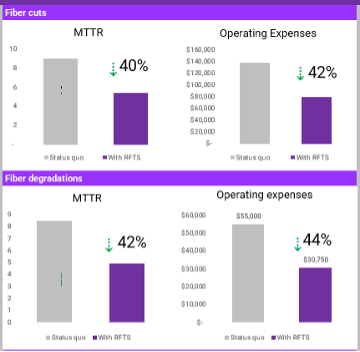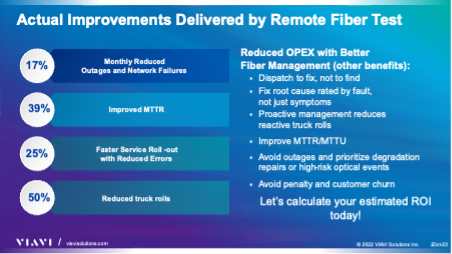Unveiling the Vital Role of Remote Fiber Test and Monitoring Systems: Reducing Mean Time to Repair and Monetizing Fiber Assets
In today’s fast-paced digital landscape, high-speed connectivity is not just a luxury; it’s a necessity. With the increasing demand for faster and more reliable network services, service providers and fiber infrastructure providers are increasingly turning to remote fiber test systems (RFTS) to guarantee fiber infrastructure availability, reduce fiber network outages, and improve service delivery. These systems can offer significant benefits to both service providers delivering high-speed 400G services and dark fiber providers offering essential fiber infrastructure.
The Need for Remote Fiber Test Systems
While fiber optic networks offer impressive benefits, they are not immune to challenges that can impact their performance. Human intervention factors such as vandalism, construction companies, or sudden environmental factors such as storms, floods, earthquakes, or fiber cable related conditions such as cable bends, signal loss, and connection disruptions can all lead to degradation of signal/service quality and network downtime. Identifying and rectifying these issues promptly is crucial to maintaining a seamless user experience. This is where fiber monitoring systems come into play.
Typical RFTS Use Cases
- Real-Time Fault Detection: continuously monitor the network for any anomalies, such as signal degradation, breaks, or bends in the cables.
- Accurate Fault Location: quickly detect the source of issues and pinpoint their exact location, minimizing downtime and facilitating rapid repairs.
- Improved Service Level Agreement (SLA) Management: reduce SLA penalties payment or outage credits for dark fiber or leased services due to network outages.
- Improved Mean-Time-To-Understand (MTTU) and Reduced Mean-Time-To-Repair (MTTR): understand your network better and repair issues faster.
- Preventive Maintenance: identify potential problems before they escalate, enabling network administrators to perform maintenance activities proactively, reducing the likelihood of sudden outages and disruptions.
The Two Main Approaches to Optical Network Monitoring
RFTS, like the VIAVI Optical Network Monitoring System (ONMSi), are sophisticated tools designed to monitor and manage the performance of optical networks. These systems are crucial for maintaining the integrity and efficiency of both lit and dark fiber networks.
- Lit Fiber Monitoring: Lit fiber refers to optical fibers that are actively carrying data. When it comes to high speed (100/200/400G) services there is typically more than one customer being served/supported so any degradation or outage will impact multiple customers. The main benefit of lit fiber monitoring is it doesn’t rely on ‘witness fibers’ to perform monitoring: In most cases a few fibers in a cable will be reserved for monitoring purposes and kept dark. It’s normally a fair assumption that if a cable is damaged, one of these witness fibers will also be impacted so you’ll get notification of a problem. However, it’s not foolproof. It doesn’t tell you about the health of the active fiber(s), and if you are leasing a fiber it’s not always guaranteed that your dark fiber provider will have witness fibers available. (And you probably don’t want to lease a second fiber just for monitoring.)
- Dark Fiber Monitoring: Dark fiber refers to unused or unlit optical fiber that is available for lease or sale. Dark fiber providers offer essential infrastructure for network expansion and connectivity. The main benefits of dark fiber monitoring are investment protection and reduced activation delays: Dark fiber may remain dormant for extended periods before being lit. Monitoring these fibers ensures that they remain in optimal condition, reducing the risk of deterioration or faults when they are eventually activated. This protects the investment made in deploying the fiber and speeds time to revenue once sold or leased.
For service providers, dark fiber providers, and data center interconnects there are several common operational benefits to installing and using remote fiber test and monitoring systems.
Proactive Issue Identification
Service providers, dark fiber providers, and data center interconnect owner/operators must ensure uninterrupted network connectivity for their clients (internal or external). Early warning of potential issues is essential to prevent disruptions to their clients’ operations. Optical network monitoring enables proactive identification of potential network anomalies. This proactive stance safeguards seamless network operation and significantly reduces the likelihood of service disruptions. By promptly identifying degradation or increasing link attenuation/loss, providers can initiate troubleshooting measures, minimizing downtime and preventing unexpected and extended service disruptions.
Precise Fault Localization
A cornerstone to reducing MTTR is precise fault localization. Optical network monitoring excels in this regard by pinpointing the exact location of a fault or break, and technicians can efficiently allocate resources and reduce the time spent on diagnosis. Dispatch to fix, not to find. This streamlined process directly translates to a reduced MTTR, allowing clients to resume operations faster and maintain productivity. The result is minimized downtime, enhanced network resilience, and a faster restoration of services for clients.
Leveraging your GIS Investment
It is paramount the optical network monitoring system can communicate with your geographical inventory system (GIS). By using future proof protocols such as API calls, the GIS can calculate the GPS coordinates of a fiber fault; then, ONMS should be able to extract this information and post it into the fault notifications such as emails and SNMP traps for faster fault location.
Enhanced Resource Allocation and Planning / Optimized Resource Allocation
Trending of historical monitoring data furnishes providers with insights into network health and performance. This data-driven approach enables providers to allocate resources strategically, ensuring that the right personnel and tools are deployed to address developing issues promptly. This optimization not only expedites repairs but also elevates the overall efficiency of network maintenance operations. The result is minimized downtime, improved customer satisfaction, and an enhanced reputation within the industry.
Elevated Service Reliability for SLA Adherence
The ultimate goal for providers is to deliver uninterrupted service to their clients. Optical network monitoring plays a pivotal role in achieving this objective. With the ability to detect and address potential issues rapidly and accurately, dark fiber providers can significantly reduce service disruptions, meaning fewer breaches of SLAs and less penalty charges paid back to customers, resulting in greater service revenue/profitability. This proactive approach not only maintains client satisfaction but also bolsters the provider’s reputation as a dependable and responsive partner in the digital ecosystem.
Improve Fiber Data Analytics and Automate Processes
In today’s world, data analysis is critical to diagnose and to prioritize actions. ONMS fiber analytics enables operational gains by providing intelligent analytics and customizable dashboards to clearly communicate actionable insights for things like proactive maintenance and repair.
ONM systems also offer customers the ability to remotely test and monitor all types of fiber networks for fiber characterization, security intrusion detection, and monitoring for degradation and fiber outages.
Upselling RFTS Services
Dark fiber providers can provide fiber network infrastructure visibility to their customers and upsell services, dashboards, and access to improve return on investment (ROI) and differentiate theirmoffer from other vendors. See this example from Windstream Wholesale.
Return on Investment
Of course, there is a cost to deploying monitoring systems. They consist of hardware, software, require investment therefore, they must be evaluated and justified. It can be difficult to gauge how well you are doing with ROI. Some of the returns are hard to quantify; for example, how to measure improvements in how your company/operation is perceived or confidence in your ability to meet MTTR or SLA commitments, reputation gains, those are tough. Some are easier though: the number of outages per year/month, average duration, typical MTTR, number of truck rolls, SLA penalty charges. All these things generate operational and business costs and should be readily available for comparison pre and post monitoring to assess ROI.



Take a look at this ONMSi RFTS ROI case study for point-to-point fiber lines (for core, metro, access, and campus networks) to see the kind of improvements that can be readily achieved.
In a world driven by data and connectivity, remote fiber test and monitoring systems have emerged as indispensable tools for ensuring the reliability, performance, and efficiency of fiber optic links. Through their ability to improve SLA adherence and dramatically reduce MTTR, ONM systems ensure that networks remain resilient, efficient, and aligned with the dynamic demands of our connected world. For service providers delivering high-speed 400G services, dark fiber providers managing fiber infrastructure, and data center interconnects handling massive volumes of data, these systems offer a competitive edge by enabling proactive fault detection, rapid troubleshooting, and informed maintenance decision-making. By bolstering adherence to SLAs and minimizing MTTR, remote fiber test and monitoring systems cement their importance in delivering reliable, efficient, and seamless network services. The real-time insights, rapid fault detection, and data-driven optimization it offers contribute to the sustained growth and success of these critical players in the digital landscape. As technology continues to evolve, investing in optical network monitoring systems is not only a wise choice but a necessary one.
To learn more, check out our Fiber Monitoring web page.
Or, to request a custom, no-obligation ROI analysis tailored to your network, fill out this brief form (please specify “ONMS ROI analysis” in the Area of Interest field).
This blog is fourth in a series on centralized fiber testing. The first three posts can be found here:
Building Quality Passive Optical Networks (PON) at Scale: Centralized Test
Unleashing the Potential of Fiber Analytics for Enhanced Network Performance
Fiber Tapping and Data Security: Unraveling the Potential Threats and Detection Methods

Douglas Clague is currently solutions marketing manager for fiber optic field solutions at VIAVI. Doug has over 20 years of experience in test and measurement with a primary focus on fiber optics and cable technologies, supporting the telecommunications industry. Prior to VIAVI, Doug held positions as manufacturing engineer, solutions engineer and business development manager. Doug has participated on numerous industry panels around fiber and cable technology trends. He attended Brunel University in London and graduated with an honors degree in electrical and electronic engineering.




